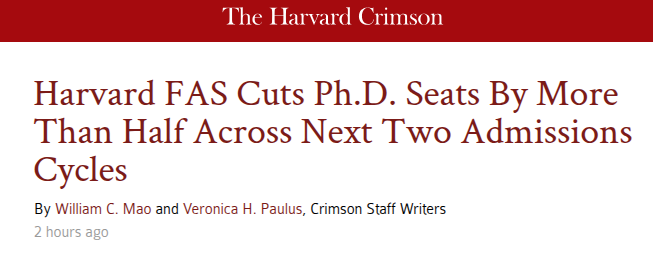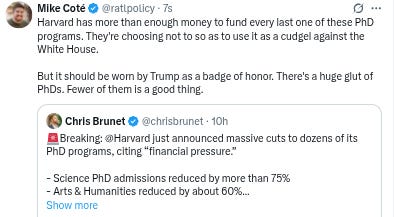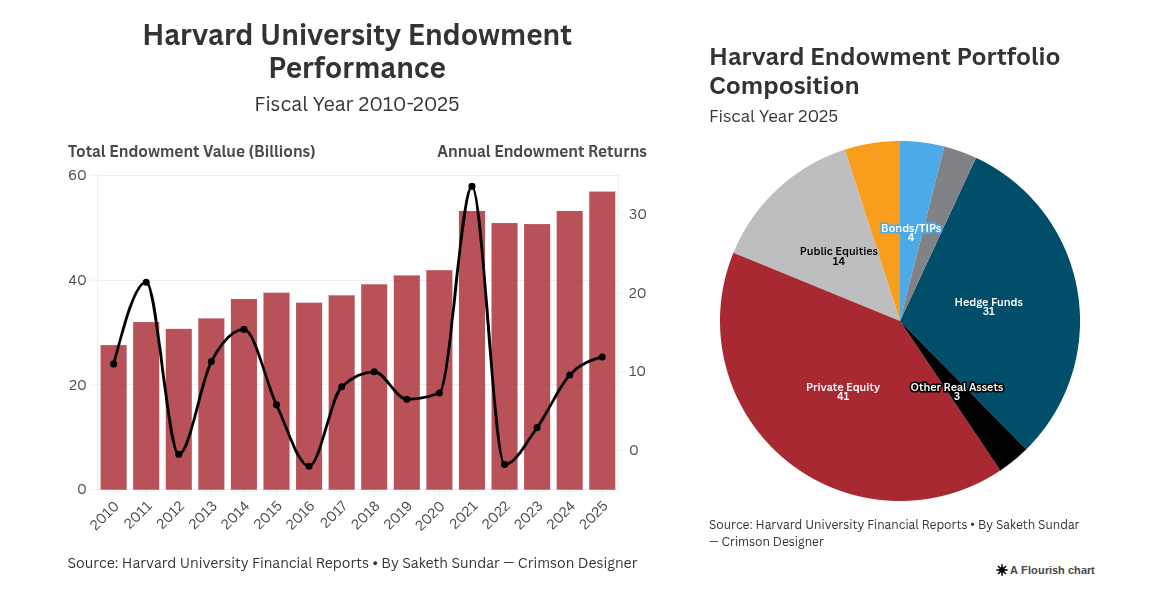Harvard's PhD Bloodbath
The wealthiest university on Earth claims it can no longer afford to train its own graduate students... so it’s reinventing itself as a trade school for mechanics?
Just after midnight last night, the Harvard Crimson quietly published a bombshell. Citing “financial pressure,” the Faculty of Arts and Sciences (FAS) announced drastic cuts to dozens of Harvard’s doctoral programs — a restructuring so deep that many graduate programs will effectively cease to exist.
According to the Crimson report, which quotes five anonymous faculty sources, the reductions are as follows:
Science PhD admissions slashed by more than 75%
Arts & Humanities cut by about 60%
Social Sciences reduced 50–70%
History down 60%
Biology down 75%
The German department will lose all PhD seats
Sociology will go from six students to zero
In addition to slashing PhD admissions, FAS has also instituted a hiring freeze for full-time staff, announced it would keep its budget flat for fiscal year 2026, and ceased work on all “non-essential capital projects and spending.”
These austerity measures follow a wave of layoffs across other Harvard schools, including the T.H. Chan School of Public Health, the School of Engineering and Applied Sciences, the Kennedy School of Government, the School of Dental Medicine, and the Graduate School of Design.
On the surface, Harvard’s austerity might appear justified. Four days ago, the university released its fiscal year 2025 financial report, revealing an operating loss of $113 million for the year ending June 30. That marks a massive reversal from the $45 million surplus it reported the year before. According to Chief Financial Officer Ritu Kalra, the deficit stems largely from the “abrupt termination of nearly the entire portfolio of our direct federally sponsored research grants” driven primarily by $116 million in reimbursements for money Harvard had ‘‘already spent’’ that “disappeared almost overnight.”
Even so, it strains belief that the richest university on Earth cannot find the resources to keep a few PhD cohorts afloat. The newly reported $113 million loss amounts to just 1.7 percent of Harvard’s $6.7 billion in annual revenue — a rounding error in Cambridge terms. Did the Faculty of Arts and Sciences really need to cut 6 sociology PhD students in order to survive? Would the school really risk insolvency if they admitted 13 History PhD students instead of 7?
Harvard’s claim of hardship collapses under even cursory scrutiny. The endowment returned $4 billion last year, climbing to $56.9 billion in total value after an 11.9 percent gain. Private equity alone now accounts for 41 percent of its holdings.
Furthermore, 2025 was a record year for donors, current-use gifts totaled around $629 million — the most in Harvard’s history, up from $528 million the prior year — yet we are told the school can no longer afford to train its own graduate students? What is the point of record ‘‘current use gifts’’ if they can’t even keep their basic PhD programs afloat? You’re really telling me in a year where their private fundraising hit an all-time high, that six history PhD stipends are what break the budget?
The entire purpose of an endowment is to help a university weather lean years without gutting its core academic programs. Yet Harvard has chosen to protect its gold pile over its scholarship, famously behaving like a hedge fund with a school attached as an afterthought. As CFO Ritu Kalra put it, the endowment is “not a source of short-term relief but a covenant across generations.” Translated from administrative jargon, that means the priority is not education but to have as big a stream of income as possible that is shielded from the influence of donors, students, and government.
And right on cue, the university’s collapse into financialized pseudo-education is now being met with a political response that’s just as absurd. Two weeks ago, President Trump announced that Harvard had reached a tentative deal with his administration to restore $2.4 billion in frozen federal grants — on the condition that it spend $500 million to create a network of trade schools for mechanics to work on ‘‘automotive plant, motors, engines,’’ which doesn’t really make any sense to me, but okay. I mean, I think funding trade schools in general is a good idea, but I am not sure that forcing Harvard to run one at gunpoint makes sense.
‘‘This would be a giant trade school, series of trade schools. It would be run by Harvard,’’ Trump told reporters in the Oval Office.
They’re going to be teaching people how to do AI and lots of other things, engines, lots of things. You know, we need people in trade schools. I remember when I went to school, I had some people that weren’t particularly good students, but they could take a motor or an engine apart blindfolded or put it back blindfolded.
So trade schools are very important and we’ve lost trade schools. We used to have a lot of trade schools in this country. We don’t have them anymore. We have tremendous plants opening and we want to have people uh at top level for those plants whether it’s AI or whether it’s auto motor plants you know we have many uh automobile companies open their plants in the United States they’re all coming back.
So, uh, by opening up trade school, because we’re going to need employees, we’re going to need people with skill. By opening up trade school, this would be a giant trade school, series of trade schools. It would be run by Harvard. Now, this is something that we’re close to finalizing. We haven’t done it yet, but they’d put up $500 million. interest and everything else would go to the trade school and you know it’s a big investment in trade school done by very smart people and then their sins are forgiven.’’
Yesterday, he again reiterated that: “They’re going to open up trade schools. And I love the idea of trade and trade schools by Harvard. So, you know, they get into like a vocational type school.”
So there it is: the richest university on Earth is claiming poverty and cutting history, philosophy, chemistry, biology, and sociology — only to reinvent itself as a glorified trade school to appease the government that froze its funding.
This is where higher education is heading. The intellectual core is being hollowed out from both directions, administrators treating universities as hedge funds, politicians treating them as job-training centers. What’s dying in the middle is the idea of the university itself: a place devoted to knowledge for its own sake.
It’s fitting that Gen Z is named after the last letter of the alphabet. They may also be the last generation to experience anything resembling a classical liberal education rather than debt-funded vocational training under corporate or state control.





Gen Z never had a traditional liberal arts education. That was ended by the Baby Boomers 40 years ago.
Er, aren’t the Graduate School of Design, and the Dental school trades?